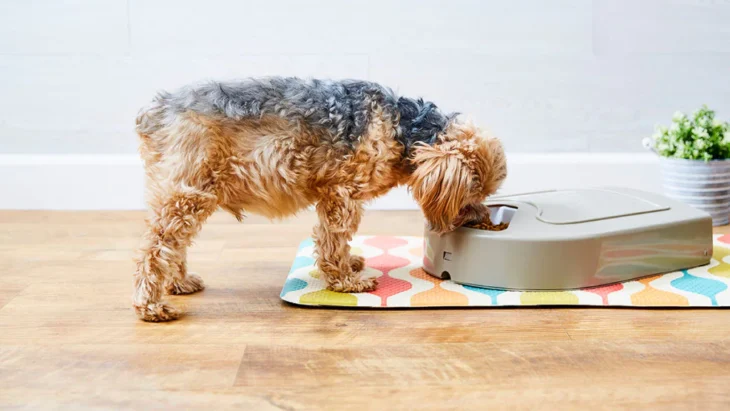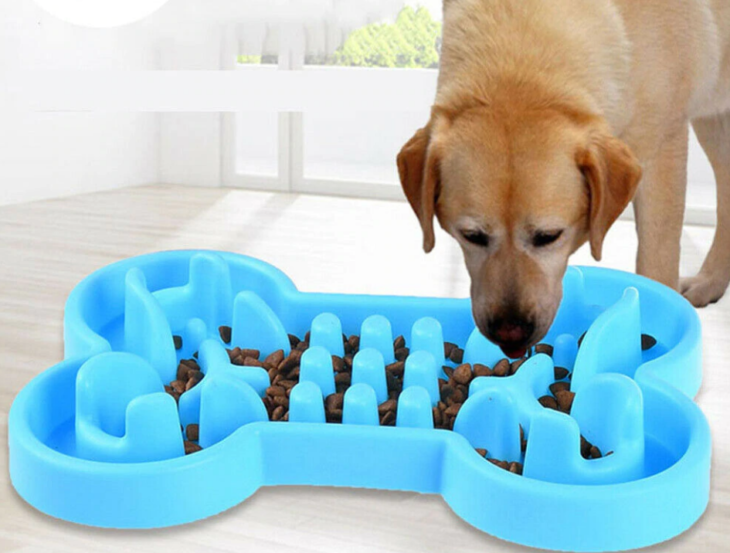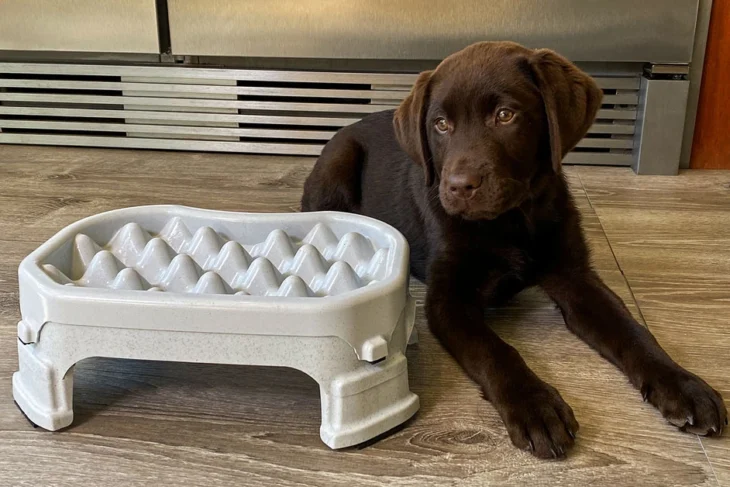Do you have a growing puppy or kitten that’s crazy with hunger and crazy with energy? Do they often vomit after overeating?
If you have a dog that has often been vomiting, we suggest getting a slow feeding system so that you can try to prevent any further occurrences.
Slow-eating meals can help overeating puppies to allow for a slower eating rate. There are several things you can do to slow down the feeding rate.
There are tons of cheap knock-offs and weak imitations out there that won’t help you out much in the long run.
Contents
What happens if your puppy eats quickly or overeats?
The most obvious reason for a fast eating speed is that some dogs are super hungry at all times of the day.
While this makes them cute in small doses, if left unchecked, it can cause serious health problems.
Overeating or quickly eating can lead to your pup developing obesity, a medical problem caused by excess body fat. Obesity can cause diabetes and arthritis.
If it eats too much food at once, its stomach and intestines may not be able to handle the sudden influx of food inside. It may lead to your pup getting sick or even bloating.
If you want to avoid the many health problems of obesity and bloat, it’s important to develop a good diet. With a proper diet, you can maintain an exercise schedule for your pup.
How can you make your dog eat slower?
There are a few ways to make your pup work harder to eat their meals. So they will be more prone to chewing slowly instead of gobbling down their food in a couple of minutes.
The first is the old “sit and wait” routine, where you make your dog sit at the table for a few seconds. They should sit until the next portion of food is released into its bowl.
This small wait will give your pup time to calm down a little and let some of his or her excitement subside.
Or you may have slow feeder dog bowls if you want your pup to eat more slowly.
Some foods also help to make your pup eat slower. Raisin and pineapple in small amounts can help slow some dogs down.
What is a slow-feed bowl?
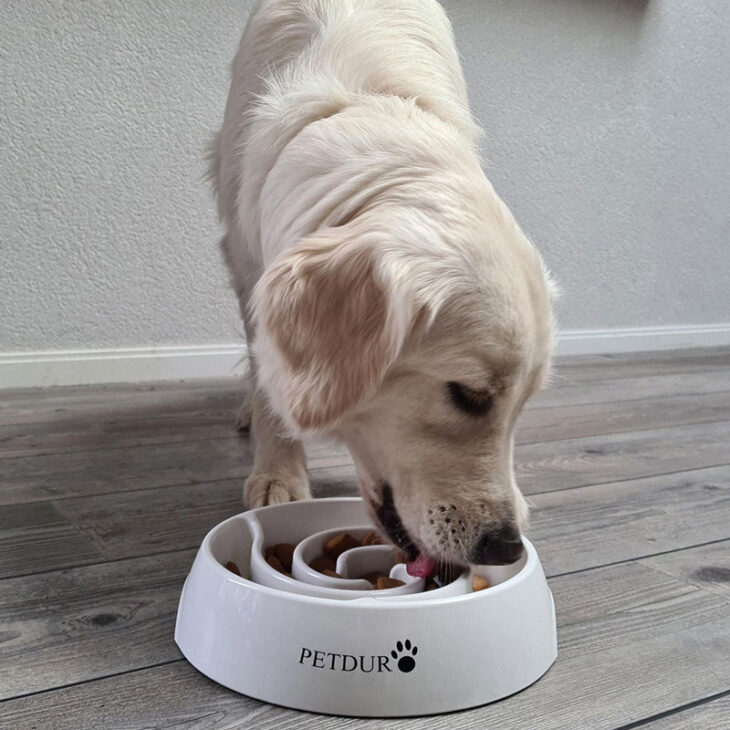
Source: petduro.com
A slow-feed bowl is a type of pet bowl that will help your dog or cat eat more slowly.
Generally speaking, your pet eats too quickly when it consumes its food in one go. There is an idea behind a slow feeder dog bowl.
By forcing dogs to work to eat their food, you can reduce the possibility of your pup eating too quickly and developing bad habits.
How Does the slow feeding bowl work?
The bowls are designed to give dogs just enough room to have a bite or two at one time.
These bowls have raised edges to stop the food from spilling out when eaten too quickly.
The different bowls have various features depending on what you want for the best possible outcome.
Feeder bowls are especially useful for pups who need to be trained on eating at the table.
As long as your pup doesn’t have a physical problem with swallowing or chewing in general, slow feeder dog bowls are pretty much a no-brainer.
Why Should You Use Slow Feeder Bowls?
Here is a list of slow feeding dog bowls from thepetstaff.com.
We know the importance of slow feeder bowls when your dog has eaten too quickly and then vomited.
Dogs and cats alike often gulp their food and water. They eat more food than needed to make themselves happy.
The problem leads to vomiting or bloating. It can be life threatening for the animals.
Slow feeder bowls help prevent this by making animals eat at their natural pace as opposed to gobbling down as much as they possibly can.
All of the bowls on our list are decently sized and accommodate the average dog or cat.
Once you get a slow feeder bowl for your pet, you can never go back to feeding them from a regular bowl.
Not only does it eliminate the risk of vomiting or bloat, but it also teaches your pet to take their time eating and not eat too fast. It also helps burn off more calories as well.
5 Things To Look for when Choosing the Best Slow Feeding Dog Bowls
Choosing the right food bowls for dogs can be challenging for pet owners. We’ve compiled five signs that will help you choose the best one.
1. Heavy-Duty Bowl
When looking for a slow-feed dog bowl, you should look for one that is heavy-duty enough to handle heavy chewing dogs.
2. Non-Slip Material
Non-slip material keeps your dog from knocking the bowl over when trying to get up from eating at the bowl. Non-slip material can make the bowl more challenging for your dog to move around, keeping happy eating in one spot.
3. Raised Edges
Dogs are attracted to anything that will help them get a few extra chews before they swallow down their current bite. Raised edges give your dog a sense of progress without actually making them chew their food more slowly by hand.
4. Chew-Proof Material
Make sure they are made with a chew-proof material. These bowls should be both durable and perfect for heavy chewers.
5. Different Colors
A good slow feeder bowl comes in at least two colors. Dogs like to have variety in their life. Make sure that you give your dog enough opportunity in its diet.
FAQ
Q:1. Which slow feeder dog bowl is best?
Ans: Not every bowl is created equally. There are plenty of feeding bowls for dogs in the market. The best are the Kong Slow Feed Bowl, Dogit Go Slow Bowl, Outward Slow Bowl, and many others brands.
Q:2. Are SLO bowls good for dogs?
Ans: These bowls are often marketed as good for senior dogs who may have trouble chewing or eating fast. They are handy and can last for a long time, so they’re great if you want to give your dog some leisurely meals during the day.
Q:3. What should you Put in Your Dog’s Food Bowl?
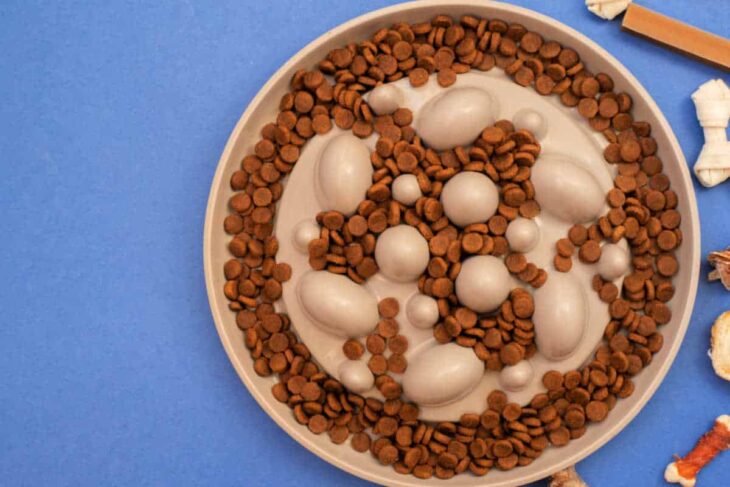
Source: ayopets.com
Ans: You can put the food that your dog enjoys. It should be no more than 40% fats and no more than 35% protein for them to lose weight.
Final Words
Not every doggy will enjoy the new challenge with this new eating method.
However, if your dog can handle the change in pace, it can greatly benefit their health and welfare in the long run.
When choosing the slow feeding dog bowls, you should be more careful about it.

